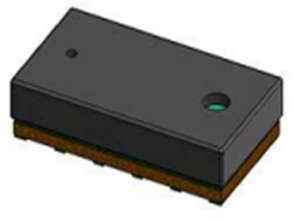- The VL53L0X is a new generation Time-of-Flight (ToF) laser-ranging module packed in the smallest possible package, offering precise distance measurements regardless of the target reflectances, in contrast to traditional technologies. It can measure absolute distances up to 2 meters, setting a new standard for performance levels and allowing for a wide range of new applications.

- In simple words it is a distance sensor, it determines the distance between the object and the sensor.
- This tiny sensor radiates the ray of light (Laser) towards the object and measures the time taken by the laser to bounce back from the object, and then it is converted into millimeters.
- This sensor uses I2C communication with the microcontroller which makes it easier to wire up with the IDE board (connect to any IDE board).
- The VL53L0X includes a state-of-the-art SPAD array (Single Photon Avalanche Diodes).
- When combined with internal physical infrared filters, the VL53L0X’s 940 nm VCSEL (Vertical Cavity Surface-Emitting Laser) emitter, which is completely invisible to the human eye, enables longer ranging distances, higher immunity to ambient light, and better robustness to cover glass optical crosstalk.
Pin Configuration
![]()
![]()
Circuit Diagram
![]()
- The AVDDVCSEL and AVSSVCSEL module pins should be as close to the capacitors on external supply AVDD as practicable.
- The I2C-bus specification includes values for external pull-up resistors. Only one pull-up is normally installed per bus, close to the host.
- 1.5k to 2k Ohms would be suggested as pull-up resistor values for an AVDD of 2.8V and a 400 kHz I2C clock.
- To prevent leakage current, the XSHUT pin must always be powered. If the host state is unknown, a pull-up is required.
- To use HW standby mode, XSHUT is required (no I2C comm).
- Recommended values for GPIO1 pull-up and XSHUT are 10k Ohms.
- If GPIO1 is not being utilized, disconnect it.
Applications of VL53L0X Sensor
- The sensor is compact and simple to utilize in any interactive or robotics project.
- Hand detection in faucets, soap dispensers, and other appliances.
- Recognition of gestures in one dimension.
- Widely used in camera autofocus to improve the camera’s performance when there is little light or a moving object.
- Used in many phones as a proximity sensor.
